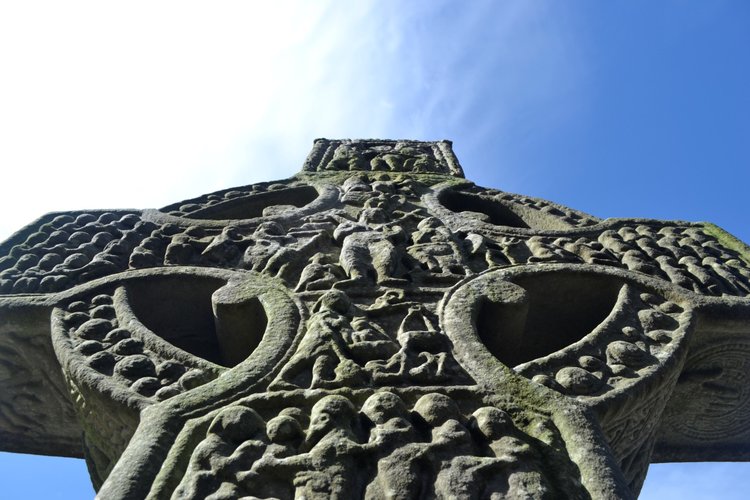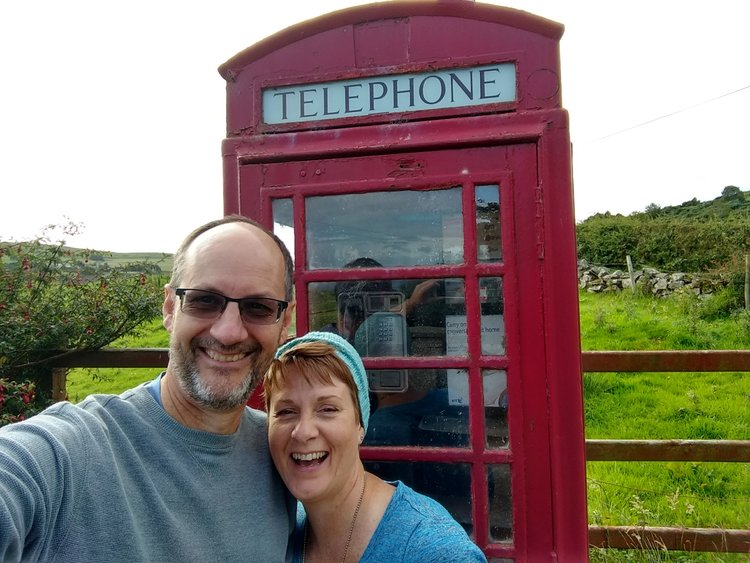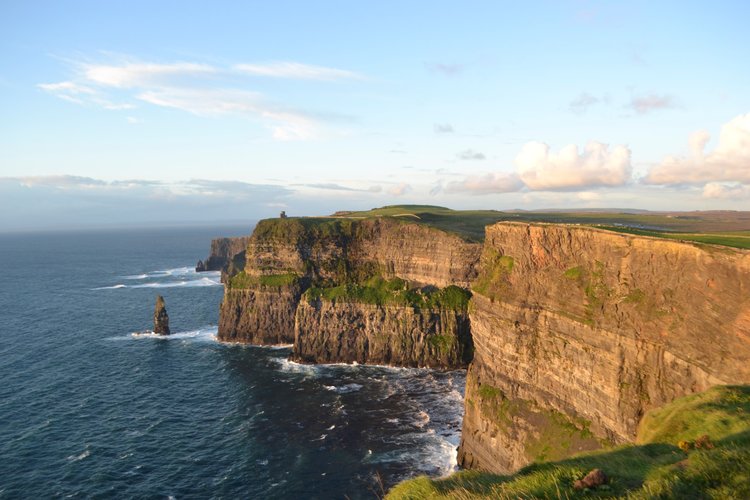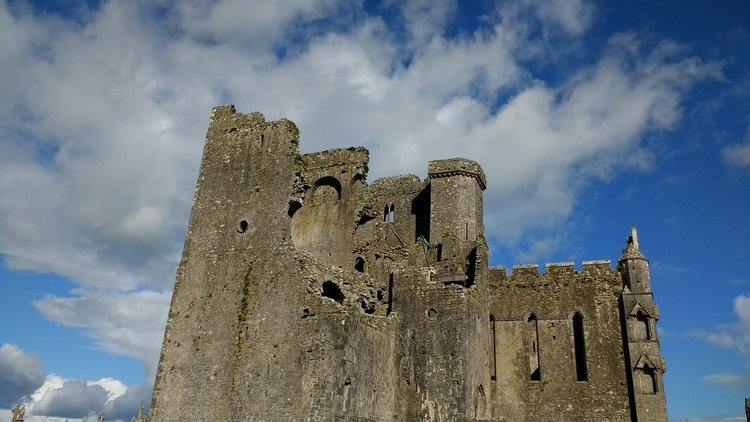Twenty-two years ago, I saw a picture of Milford Sound, New Zealand in a travel agent's window.
"I don't know where this is," I said to Andy, "But I want to go there."
A few weeks later, we were in a camper van, on the road in New Zealand, with Milford Sound as our destination, stopping along the way for anything that looked interesting and exciting.
Our trip to Ireland was composed this same way: beautiful images of far-flung places, stitched together with many kilometers of scenic roadways and surprising stops along the way. We drove a counter-clockwise ring around Ireland, from Dublin, up to Belfast, along the Antrim Coast, down the west coast, and back through the center of the country to Dublin.
This was not a trip for the city-lover. Although we did visit and enjoy the wonderful cities of Dublin and Belfast and Londonderry, the cities were, for us, gateways to the open road and the beautiful, wild places.
The absolutely fantastic thing about Ireland is that you've arrived in the land of the B&B and the pub. So, you can drive as far as you want, hike to your heart's content, and at the end of the day, someone will serve you up a wonderful dinner and a pint. There will be music, and a fluffy duvet to burrow into until the morning comes.
Bring your rain jacket and your waterproof hiking boots, and you're good to go.
So, without further adieu, here's our five days of driving through much of Ireland and Northern Ireland.
Day 1: Dublin to Belfast
We landed in Dublin early, rented our car, and headed north.
Or, as the signs on the motorway say in all caps, The NORTH.
Like a prophecy. Like a portent.
Our very first stop was the World Heritage site, Bru na Boinne, a Neolitic passage tomb older than the pyramids at Giza. I wept like a child inside the tomb called Newgrange, and then couldn't speak without crying for an hour or so after. It was one of the most deeply moving spiritual experiences of my life, feeling a deep connection to humanity throughout history, and the oneness of our common experiences with death, sorrow, hope, and light.
I've written more about Bru na Boinne and my experience, here.
Newgrange, Bru na Boinne
Our next stop was Monasterboice, site of a monastery founded sometime around 500 AD. The high crosses here, including the highest in Ireland, date from the 9th or 10th century.
Monasterboice High Cross
We stopped for lunch at the Monasterboice Inn. Don't worry, I'm not going to show you all our meals, but this one includes our first pint of Guinness, and the meal itself featured potatoes three ways: topping the Cottage Pie, and side dishes of mashed potatoes and chips. We shared, because there was Sticky Toffee Pudding for dessert. HEAVEN.
Heaven on many plates, and in some glasses, too
After lunch, we wandered The Peace Maze at Castlewellan. I wanted to find some labyrinths to walk on this trip, and when I Googled labyrinths, this came up. It was gorgeous, and almost deserted, exactly the way we like our tourist attractions to be. We were entering Northern Ireland at this point, and with its long history of troubles and painful division, a peace maze seemed like a spiritually appropriate beginning.
Peace Maze, Castlewellan
By this time, it was late afternoon so we quickly nipped in to DownPatrick to pay our respects at the Grave of St. Patrick, quite remarkably humble and secluded, behind the cathedral.
St. Patrick's Cathedral, Downpatrick
St. Patrick's Grave
We spent the night at a Hilton in Belfast--the worst bed of the trip, but the best breakfast. Fried soda bread. Why don't we have this in America?
Here we learned that our GPS can't pronouce the Irish any better than we can. In fact, the GPS chick took words I can figure out, like "Templepatrick" and made them into unrecognizable things like "TempLEPatrick." As a result, we couldn't always figure out what GPS-chick was trying to tell us. Fortunately, roundabouts (rather than stoplight junctions) mean that you can just keep going around and around until you get back to the road you were supposed to follow.
Day 2: Belfast to Portrush
Our first stop of the day was The Dark Hedges in Balleymoney. It's one of the most-photographed sites in Ireland, and was the film location for The Kings Road early on in Game of Thrones. We got there really early and had it all to ourselves.
The Dark Hedges
After The Dark Hedges, we headed for the village of Cushendun on the coast, via the Glendun Scenic Route. It was so beautiful, so lonely and wild.
Glendun Scenic Route
Arriving in Cushendun, we went to climb around in this cool cave area we'd read about, and then found a sign saying that it was a Game of Thrones location, too.
The narrow roads in this area were bounded by huge hedges of fushcia in full bloom, and giant brambles of ripe blackberries.
We'd seen so many enormous hedges by this point that I started hypothesizing that a biological imperative toward hedge-planting is likely an accurate test of whether you've got Irish roots. Forget ancestry.com. Do you feel a deep-seated need to plant hedges? You're probably Irish.
We found our first red telephone box near Torr Head, where we stopped to climb the hill for a majestic view along the coastline.
After spending the morning in this very remote and quiet area, we hit three tourist traps in the afternoon: Carrick-a-Rede rope bridge, the Bushmill's Distillery tour, and Giant's Causeway.
The rope bridge at Carrick-a-Rede connects a tiny island to the mainland, and was first built by local salmon fishermen, before America was even a country. It's a tourist trap because it's cool!
Giant's Causeway is another World Heritage Site and simply spectacular. There are tons of people around, but if you wait til just the right moment, you can get a shot without humans in it. The guards told us we were too close to the edge and in danger of being washed away by crashing waves, so clearly a fine time was had by all.
Carrick-a-Rede
Bushmill's Distillery Tour, with a thimbleful of whiskey at the end
Giant's Causeway
We stopped by Dunluce Castle (Castle Greyjoy in GoT), where we were too late to get inside for a tour, but were able to climb around the outside, and even found a sea-cave that comes in under the walls.
Day 3: Londonderry to the Cliffs of Moher
We started our day walking the medieval walls of Derry. I took this photo on the wall near Bishop's Gate, and if you look on either side of the cannon, you can see Protestant church spires on one side, Catholic on the other. I was glad we had already walked the Peace Maze before we walked the walls.
City Walls, Derry
Other than getting to the Cliffs of Moher for sunset, we didn't have set plans for the day. Andy looked along our route and decided we'd drive through Glengesh Pass to another set of cliffs called Slieve League, taller than the Cliffs of Moher, but very remote and less visited.
When we arrived at Slieve League, we hiked up from the car park, past a lot of sheep, through gale-force winds, to a good picnic spot. We were eating a sandwich on a bench near the cliffs, when we saw a bit of a rainbow.
This, in fact, was Rainbow Number 12 for the day. But we were still liking them, so Andy took this picture.
Then we realized that the wind, blowing strongly toward us, was pushing the clouds rapidly inland. As the clouds cleared, the rainbow kept growing and growing and growing, getting brighter and brighter and brighter.
For at least ten minutes, we sat spell-bound, watching this rainbow being born, until a complete arch formed all across the cliff face.
At this point, we called the trip a raging success and everything that happened afterward, a bonus.
On this particular day, the bonus included WB Yeats' resting place in Drumcliff, the ruins of Clare Galway Franciscan Priory (now inhabited mostly by birds, St. Francis would approve), and the Cliffs of Moher (aka The Cliffs of Insanity from The Princess Bride) at sunset.
Treading just lightly on WB Yeats' dreams
Clare Galway Franciscan Priory
Sunset on the Cliffs of Moher, when the tourist crowds are gone: spectacular
Day 4: Dingle & Rock of Cashel
We got up early on Day 4 for a long drive around Slea Head Drive, Dingle. Afterward, we turned back inland to Rock of Cashel, headed back toward Dublin. This was a very long days' drive, and that informed our decision to drive the smaller peninsula of Dingle, rather than the larger and more well-known Ring of Kerry directly to the south. We were perfectly happy with our Dingle-drive decision. No regrets at all, when your lunch spot looks like this. No filter.
Slea Head Drive, Dingle
Rock of Cashel
Day 5: Back to Dublin
Day 5 begins with the sad tale of Irish breakfast tea gone amuck.
We spent the night at the lovely country home of Helen, whom we discovered through Air BnB. Helen's home had the distinction of being the only place we stayed where there was a hair dryer (note, I wore a hat most of the trip). More importantly, it was the place of the tea disaster.
Helen was a very friendly person who gave us great advice for our Day 6 itinerary, plus the run of her kitchen for breakfast. She told us how to make ourselves REAL Irish breakfast tea, with leaves, in a pot, and not with those desecrations to good tea known as tea bags.
So, the morning of Day 5 arrived, Helen was off to work and we were on our own with the detailed tea instructions we had received. We boiled the water, made the tea, sugared it, took a sip, and both went, "Faugh!"
(Really, there's no other word. Faugh is the best I can come up with.)
"Why is this so SALTY? Is real Irish tea made with seawater?"
We could not understand why anyone would drink salty tea.
But in Scotland, they have haggis, so Irish tea might be salty.
Who knows.
Human taste is a mystery.
"There's no right or wrong," we said, "To each his own," we said, but we could not drink this tea.
So we poured it out (sorry, Helen, sorry!!!) and went with the substandard tea bags for round two.
Meanwhile, poking around on the table, I found a ramekin of brown sugar and decided to try that instead of the white sugar in my second cup of tea. The open bowl of white sugar was fairly depleted from our previous use, and I wanted to leave that for Andy. So I fixed up my second cup of tea with brown sugar, and he dumped the remaining white sugar into his second cup.
"Faugh!" he says again, "Faugh!"
And that's when we realized: the little open bowl of white sugar, with which we fixed our first cups tea, and with which Andy fixed his second cup of tea: SALT.
After slinking away from the tea-disaster at Helen's, we managed to find ourselves in the best ruin of the trip: the Rock of Dunamase. It was very early, we were alone in the quintessential Irish countryside, surrounded by rolling fields full of new-mown hay and grazing sheep. Nobody stopped Andy from climbing the walls, and I took a lot of pictures of old rocks and ivy.
I waded through hay and brambles to take my favorite photo of the trip, looking back at Dunamase. Traveling in September, the rose hips were gorgeous everywhere and made wonderful frames for so many beautiful scenes.
Castle Dunamase
From Dunamase, we drove through the majestic scenery of the Wicklow Mountains National Park, to the estate of Powerscourt with its beautiful waterfall and gardens.
Powerscourt Estate
Finally, we wound up back in Dublin where we visited the Book of Kells and the Long Reading Room at Trinity College, then said farewell to the Irish countryside on the hill at Tara of the Kings.
Long Reading Room, Trinity College
Tara of the Kings
That night, we had dinner and a cider at Merchant's Arch, where the music was not traditional, but where Stevie and Lee made themselves heroes when they mixed Let It Be with No Woman, No Cry. The Beatles and Bob Marley, together, and everybody singing at the top of their lungs: musical perfection.
Thank you, Dublin. You did not disappoint.
A Word to the Wise: Travel Tip
It rains a lot in Ireland, which means endless green hills, spectacular rainbows, and misery for you, if you don't come prepared. A good waterproof jacket and waterproof shoes are absolutely essential to your enjoyment of Ireland.
Visit our product recommendations for jackets and shoes, and have a wonderful time in Ireland!































